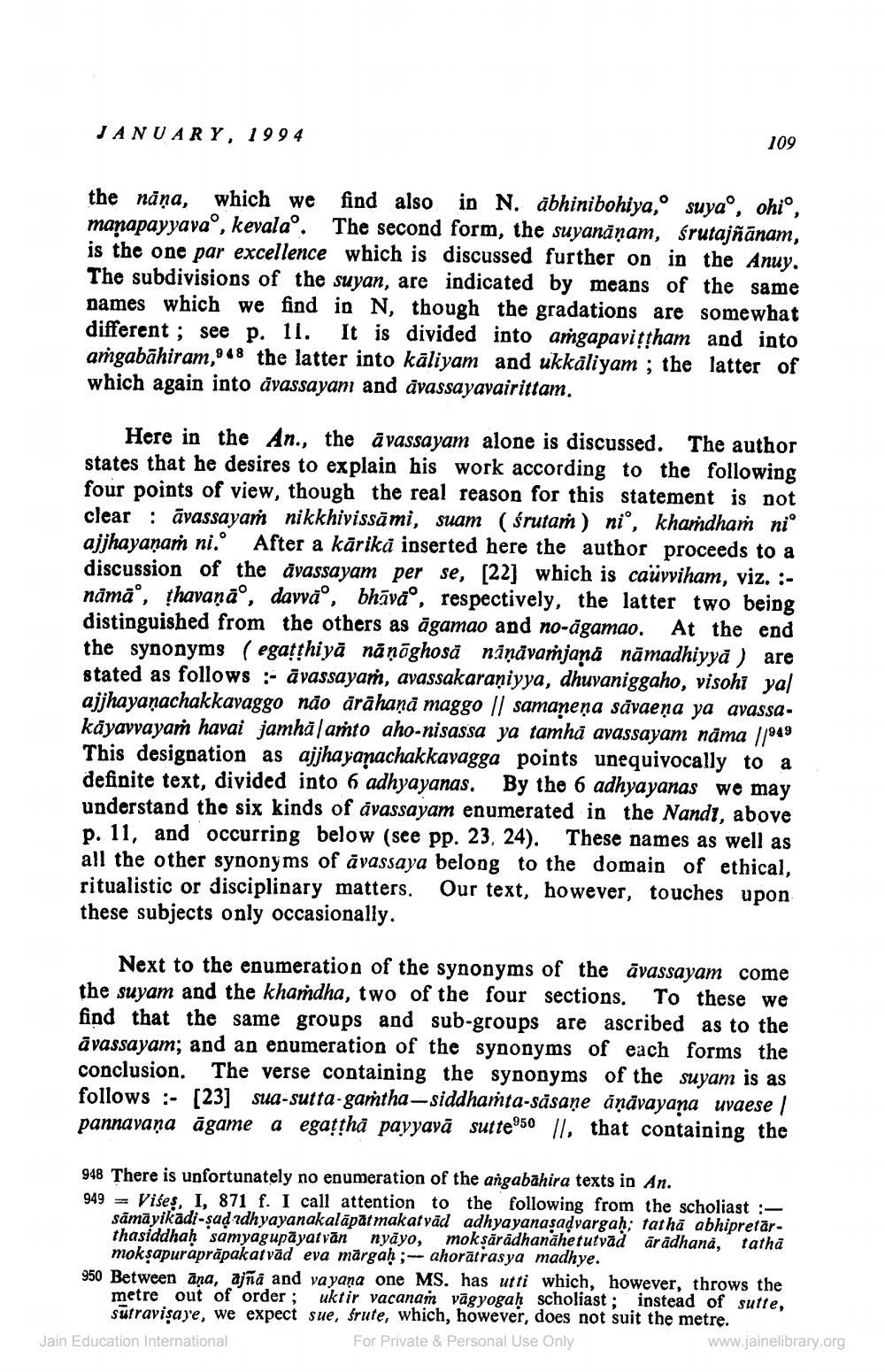Book Title: Jain Journal 1994 01 Author(s): Jain Bhawan Publication Publisher: Jain Bhawan Publication View full book textPage 9
________________ JANUARY, 1994 109 the nāņa, which we find also in N. ábhinibohiya,' suyao, chio, manapayyava', kevalao. The second form, the suyanāņam, śrutajñānam, is the one par excellence which is discussed further on in the Anuy. The subdivisions of the suyan, are indicated by means of the same names which we find in N, though the gradations are somewhat different ; see p. 11. It is divided into aṁgapavittham and into amgabāhiram,948 the latter into kāliyam and ukkaliyam ; the latter of which again into avassayam and avassayavairittam. Here in the An., the avassayam alone is discussed. The author states that he desires to explain his work according to the following four points of view, though the real reason for this statement is not clear : āvassayam nikkhivissāmi, suam (śrutam) ni', khandha ni® ajihayanaṁ ni. After a kārikå inserted here the author proceeds to a discussion of the avassayam per se, [22] which is caüyviham, viz. :nāmā”, thavaņā°, davão, bhāvao, respectively, the latter two being distinguished from the others as āgamao and no-agamao. At the end the synonyms (egatthiyā nāņāghoså niņāvaṁjana nāmadhiyya ) are stated as follows :- āvassayam, avassakaraniyya, dhuvaniggaho, visohi yal ajjhayaņachakkavaggo não årāhaņā maggo || samaneņa sāvaeņa ya avassakäyavvaya havai jamhä/aṁto aho-nisassa ya tamhä avassayam nama //949 This designation as ajjhayanachakkavagga points unequivocally to a definite text, divided into 6 adhyayanas. By the 6 adhyayanas we may understand the six kinds of avassayam enumerated in the Nandı, above p. 11, and occurring below (see pp. 23, 24). These names as well as all the other synonyms of avassaya belong to the domain of ethical, ritualistic or disciplinary matters. Our text, however, touches upon these subjects only occasionally. Next to the enumeration of the synonyms of the āvassayam come the suyam and the khamdha, two of the four sections. To these we find that the same groups and sub-groups are ascribed as to the āvassayam; and an enumeration of the synonyms of each forms the conclusion. The verse containing the synonyms of the suyam is as follows :- 23] sua-sutta-gaṁtha-siddhaṁta-säsane änavayana uvaese / pannavaņa āgame a egathā payyavā sutte950 ll, that containing the 948 There is unfortunately no enumeration of the angabahira texts in An. 949 = Višes. I, 871 f. I call attention to the following from the scholiast : sāmāyikadi-sad adhyayanakalāpat makatvād adhyayanasadvargah; tathā abhipretārthasiddhah samyagupayatvẫn nởãyo, moksārādhanahetutvadar adhana, tatha moksapurapräpakatvād eva mārgah ; - ahorātrasya madhye. 950 Between ana, ajña and va yana one MS. has utti which, however, throws the metre out of order; uktir vacanam vägyogaḥ scholiast; ipstead of sutte, sutravisaye, we expect sue, śrute, which, however, does not suit the metre. Jain Education International For Private & Personal Use Only www.jainelibrary.orgPage Navigation
1 ... 7 8 9 10 11 12 13 14 15 16 17 18 19 20 21 22 23 24 25 26 27 28 29 30 31 32 33 34 35 36 37 38 39 40 41 42 43 44 45 46 47
